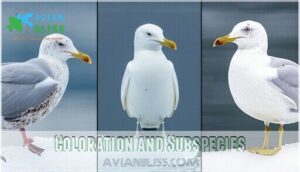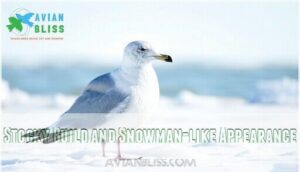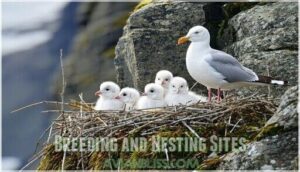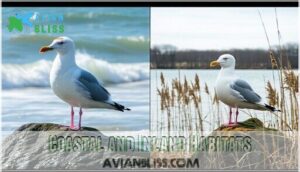This site is supported by our readers. We may earn a commission, at no cost to you, if you purchase through links.
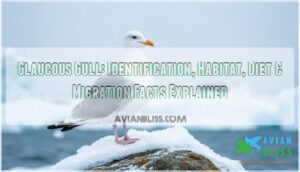
These Arctic specialists boast impressive wingspans reaching nearly six feet and sport snow-white plumage with subtle gray backs in adults.
They’re opportunistic feeders who’ll tackle everything from fish and carrion to small mammals, making them formidable scavengers along northern coastlines.
During winter, you might spot these powerful fliers migrating south to temperate waters, though they remain tied to coastal environments year-round.
Their stocky build and confident demeanor make them stand out among gull flocks, especially when they’re asserting dominance at feeding sites.
Table Of Contents
- Key Takeaways
- Glaucous Gull Identification
- Habitat and Distribution
- Diet and Foraging Habits
- Behavior and Social Structure
- Life History and Migration
- Frequently Asked Questions (FAQs)
- How do you identify a glaucous gull?
- Where do Glaucous Gulls live?
- What is the difference between American herring gull and glaucous gull?
- Where are Glaucous Gulls found?
- What is the difference between a Herring Gull and a glaucous gull?
- How do you identify a Glaucous-winged Gull?
- What do Glaucous Gulls eat?
- Can Glaucous Gulls be found in urban areas?
- Do they form long-term monogamous relationships?
- Are Glaucous Gulls known to be noisy birds?
- Conclusion
Key Takeaways
- You’ll spot a glaucous gull by its hefty, snowman-like build, pale gray back, and pure white wingtips—no black markings like other large gulls.
- You’ll find these Arctic specialists breeding in remote northern regions and migrating to temperate coastlines during winter, always sticking close to water.
- You’ll notice their aggressive feeding habits—they eat anything from fish and carrion to small mammals and dominate feeding sites.
- You’ll see strong pair bonds during breeding season, with both parents sharing nesting duties and returning to the same sites year after year.
Glaucous Gull Identification
You’ll easily recognize a Glaucous Gull by its massive size and distinctive "snowman" appearance, with a stocky build that’s larger than a Herring Gull but smaller than a Great Black-backed Gull.
This Arctic giant’s pale wings and hefty build make it unmistakable among seabirds.
Look for the pale gray back, white wingtips, thick yellow bill with a red spot, and the characteristic small eyes that give this Arctic giant its unique profile, featuring a massive size.
Size and Measurements
You’ll recognize a glaucous gull by its impressive size and measurements that place it among nature’s largest gulls.
Weighing between 1.2-2.3 kilograms with wingspan extremes reaching 170 centimeters, these birds show notable sexual dimorphism as males typically exceed females in size.
Immature size gradually increases over four years, while subspecies size variations reflect their Arctic distribution across different regions.
Coloration and Subspecies
You’ll spot adult glaucous gulls by their pale gray upperparts and pristine white wingtips – a combination that sets them apart from darker-backed relatives.
Four subspecies exist, with Larus hyperboreus pallidissimus being the palest and largest form.
Young birds display creamy-buff plumage without black markings, taking four years to develop full adult coloration.
- Adult glaucous gull perched on ice with snow-white wingtips gleaming against pale gray wings
- First-year bird showing biscuit-brown plumage gradually lightening to creamy white tones
- Side-by-side comparison revealing subtle size differences between barrovianus and nominate subspecies
Stocky Build and Snowman-like Appearance
This Arctic giant’s hefty frame and oversized head create an unmistakable snowman silhouette that dominates icy coastlines.
You’ll instantly recognize the glaucous gull’s distinctive stocky build that gives it a "snowman" appearance among large gulls.
This bird’s physical traits include a deep chest, heavy bill, and oversized head that makes its eyes appear relatively small.
The glaucous gull’s size and shape fall between a crow and goose, creating an unmistakable silhouette that sets it apart from other seabirds.
Observing the beak shape reveals the bird’s feeding habits.
Habitat and Distribution
You’ll find Glaucous Gulls in some of the world’s most remote Arctic regions, from Alaska’s icy coastlines to Greenland’s towering cliffs.
These hardy birds migrate thousands of miles each winter, trading their harsh Arctic breeding grounds for temperate coastlines where they’ll hunt along beaches and scavenge at harbors.
Breeding and Nesting Sites
After picking out a Glaucous Gull by its hefty build, you’ll find its breeding sites are often remote Arctic cliffs or rocky ground.
Colony size varies, but nests are usually spaced out.
They use grasses, moss, and feathers as nest materials, and site fidelity is strong—many return year after year.
Chick development is rapid, boosting nesting success in harsh environments, and these birds often require a sturdy base for nests.
Wintering Areas and Migration
You’ll find these Arctic birds following predictable migration routes as they escape freezing temperatures.
Most Glaucous Gulls winter along North Atlantic and Pacific coasts, reaching as far south as the British Isles and northern United States.
Their wintering areas include Great Lakes regions, with some individuals traveling to northern Mexico, and these stopover sites provide essential resources during their September-October migration from Arctic breeding grounds.
They often return to breeding colonies, displaying high nest site fidelity, which is a notable example of high nest site fidelity in birds, showcasing their strong migration patterns.
Coastal and Inland Habitats
Along rugged coastlines and far-reaching inland habitats, you’ll notice glaucous gulls adapting with ease.
Their habitat adaptations help them thrive despite climate change and human impact.
Inland expansion is common as gulls search for food and safe nesting.
Watch for these signs of gull habitat use:
- Coastal habitats battered by storms
- Inland lakes and reservoirs
- Bird behavior shifting with habitat loss
Diet and Foraging Habits
You’ll discover that glaucous gulls are opportunistic omnivores with an impressive appetite for variety.
These Arctic giants scavenge everything from fish and mollusks to bird eggs and refuse, often dominating feeding areas with their aggressive behavior.
Omnivorous Diet
Glaucous gulls showcase remarkable dietary adaptations, consuming everything from fish and marine invertebrates to birds, eggs, and small mammals.
This prey variety includes mollusks, crustaceans, rodents, insects, berries, and carrion.
Their omnivorous diet shifts seasonally—coastal scavenging dominates winter months while inland feeding increases during Arctic summers.
You’ll find their opportunistic eating habits make them successful in harsh environments where specialized feeders struggle.
They’re commonly found in coastal and Arctic regions during breeding and wintering, which is a key aspect of their harsh environments.
Scavenging Behavior
You’ll spot these adaptable gulls turning urban areas into their personal buffets.
Their dietary plasticity shines through landfill dependence, where they compete with other scavengers for refuse.
This resourcefulness lets them exploit human waste streams while avoiding direct competition with smaller gull species.
Urban scavenging showcases classic gull behavior – they’ll grab whatever’s available.
Their opportunistic feeding habits reflect complex scavenging patterns, which is a result of their dietary plasticity and ability to thrive in urban areas.
Feeding on Carrion and Small Mammals
When available, carrion becomes a protein-rich jackpot for glaucous gulls.
They readily consume dead fish, marine mammals, and birds washed ashore.
Small mammals like lemmings and ground squirrels also fall prey to their hunting prowess.
This dietary adaptability helps glaucous gulls thrive in harsh Arctic environments where food sources vary seasonally.
They, like vultures, are opportunistic feeders that consume carrion, making them opportunistic feeders in their ecosystem.
Behavior and Social Structure
You’ll notice that glaucous gulls show strong pair bonds and often nest in colonies, but they don’t shy away from aggressive behavior when defending territory or food.
Their social structure shifts with the seasons, so you might see them alone or in small groups outside of breeding times, exhibiting strong pair bonds in certain contexts.
Aggressive Behavior
Aggressive behavior defines gull species, and you’ll witness this trait prominently in these Arctic predators.
Their behavioral traits include intense food dominance and relentless scavenging competition that makes them formidable bullies among seabirds. Understanding bird social hierarchy helps explain these behaviors.
Key aggressive behaviors include:
- Kleptoparasitism – Stealing food from smaller gulls through intimidation
- Nest raiding – Attacking eggs and chicks of other seabird colonies
- Intraspecific aggression – Fighting with other glaucous gulls over territory
- Feeding habits dominance – Monopolizing carcasses and refuse dumps
- Bully behavior – Using size and vocal intimidation to exclude competitors
Strong Pair Bonds
Despite their aggressive nature, glaucous gulls form remarkably strong monogamous pairs during breeding season.
You’ll find these Arctic birds maintaining mate fidelity year after year, with divorce rates remaining surprisingly low compared to other seabirds.
Their courtship rituals involve elaborate displays where partners share parenting duties equally throughout the nesting period.
| Pair Bond Aspect | Glaucous Gull Behavior | Comparison to Other Gulls |
|---|---|---|
| Mate Fidelity | High – pairs reunite annually | Similar to other large gulls |
| Courtship Rituals | Head bobbing, regurgitation feeding | More elaborate than smaller species |
| Shared Parenting | Both sexes incubate and feed young | Standard among gull species |
| Long-term Bonding | Multi-year partnerships common | Above average for seabirds |
| Divorce Rates | Low – typically only after breeding failure | Lower than many gull species |
Their ability to form strong monogamous pairs and exhibit low divorce rates is notable among seabirds, showcasing a unique aspect of glaucous gull behavior.
The elaborate displays of courtship rituals and the practice of shared parenting highlight the complexity of their social bonds.
Colony Nesting
You’ll find glaucous gulls nesting in both large breeding colonies and smaller groups, depending on available nesting sites.
Colony size varies dramatically from just a few pairs to several hundred birds clustered together on Arctic cliffs.
These colonial defense strategies help protect eggs and chicks from predators, though nesting density remains relatively low compared to other gull species, ensuring adequate breeding success and maintaining site fidelity across seasons, which is crucial for their breeding success.
Life History and Migration
You’ll discover that glaucous gulls follow remarkable life patterns shaped by Arctic extremes.
These powerful birds migrate thousands of miles between breeding grounds and wintering areas, adapting to harsh conditions that would challenge most species.
Breeding and Nesting
Glaucous Gulls form strong pair bonds and typically return to familiar breeding territories each spring.
You’ll find their colonies scattered across Arctic coastlines and rocky islands where they construct simple ground nests.
Their breeding success depends on several key factors:
- Nesting Materials – They gather seaweed, grass, and moss to create shallow depressions lined with soft vegetation
- Clutch Size – Females lay 2-4 olive-colored eggs with dark brown spots, with 3 being most common
- Chick Development – Young birds fledge after 45-50 days of intensive parental care and feeding
- Nesting Success – Remote nest sites protect against predators, though harsh Arctic weather poses constant challenges
Both parents share incubation duties for 27-28 days, taking turns protecting their clutch from harsh Arctic conditions.
They often seek out the best nesting supplies to guarantee a safe environment.
Migration Patterns
Once nesting season winds down, these gulls set off along classic bird migration routes.
You’ll see them tracing Arctic Movements, heading to bird wintering areas along coastlines from Alaska to Europe.
Ice Influence shapes their journey, with some sticking close to southern pack ice, and key bird stopover sites like the Great Lakes offer rest before reaching final wintering locations, influenced by the Ice Influence.
Adaptation to Arctic Environment
As you follow the Arctic gull’s migration, you’ll notice how it thrives in harsh Arctic regions.
This seabird’s survival toolkit includes:
- Cold Tolerance—dense down and fat reserves.
- Ice Foraging—strong bills crack frozen prey.
- Plumage Camouflage—blends with snow and ice.
- Breeding Success—timed with food peaks.
These adaptations help glaucous gulls withstand resource scarcity, and their ability to thrive is a testament to their breeding success.
Frequently Asked Questions (FAQs)
How do you identify a glaucous gull?
Looking for this Arctic "ghost" among gulls? You’ll spot its stocky, snowman-like build with a massive yellow bill sporting a red spot.
Adults show pale gray backs with distinctive white wingtips—no black markings like other large gulls.
Where do Glaucous Gulls live?
You’ll find these Arctic wanderers breeding across Alaska, northern Canada, Greenland, Iceland, and Russia’s frozen coastlines. They winter along temperate shores from Newfoundland to North Carolina, and Alaska to Washington.
What is the difference between American herring gull and glaucous gull?
Like comparing a gentle giant to its smaller cousin, you’ll spot key differences between these gulls.
Glaucous gulls are larger, stockier, with all-white wingtips and pale gray backs, while herring gulls have black wingtips and darker coloring, making them distinct in terms of coloring.
Where are Glaucous Gulls found?
You’ll find Glaucous Gulls across Arctic regions globally, including Alaska, Canada, Greenland, Iceland, northern Europe, and Russia.
They winter along temperate coastlines from Newfoundland to North Carolina, Alaska to Washington, and similar latitudes in Europe and Asia.
What is the difference between a Herring Gull and a glaucous gull?
You’ll spot the key differences in size and wing coloring.
Glaucous Gulls are larger with stocky builds and pure white wingtips, while Herring Gulls are smaller with black wingtips and different wing patterns.
How do you identify a Glaucous-winged Gull?
Check the bird’s wingtips first—they’ll be gray, not black like other gulls.
Adult Glaucous-winged Gulls have pearly gray wingtips that match their back color, making them easy to distinguish from black-tipped species.
What do Glaucous Gulls eat?
You’ll notice these birds aren’t picky eaters.
They’ll grab fish, mollusks, crustaceans, birds, eggs, and even scavenge garbage.
If there’s food around—on land or sea—they’ll make a meal of it.
Can Glaucous Gulls be found in urban areas?
You won’t typically find Glaucous Gulls in urban areas since they prefer Arctic coastlines and remote habitats.
They occasionally visit coastal cities during winter migration, especially harbors and fishing ports near northern waters.
Do they form long-term monogamous relationships?
Like two peas in a pod, these gulls usually form long-term monogamous pairs.
You’ll find both parents sharing nesting duties, raising young together, and returning to the same breeding sites year after year, weather permitting.
Are Glaucous Gulls known to be noisy birds?
You’ll notice Glaucous Gulls aren’t particularly vocal compared to other gull species.
They produce deep, hoarse calls like "kau-kau-kau" or "kuwaaaah," but they’re less gregarious and noisy than their smaller cousins.
Conclusion
Like a sentinel standing guard over the Arctic’s icy waters, the glaucous gull remains one of nature’s most impressive coastal predators.
You’ve now learned to identify these powerful birds by their pale plumage, massive wingspan, and distinctive lack of dark wingtips.
Understanding their opportunistic feeding habits, aggressive behavior, and seasonal migration patterns will help you appreciate encounters with these formidable Arctic specialists.
Whether you spot a glaucous gull scavenging along northern shores or wintering in temperate waters, you’ll recognize their commanding presence and remarkable adaptations to harsh coastal environments, making them a notable example of Arctic specialists.


